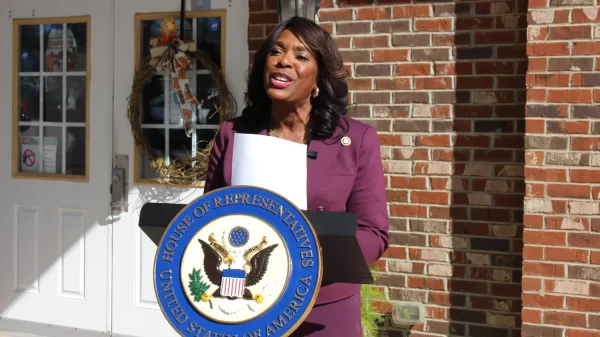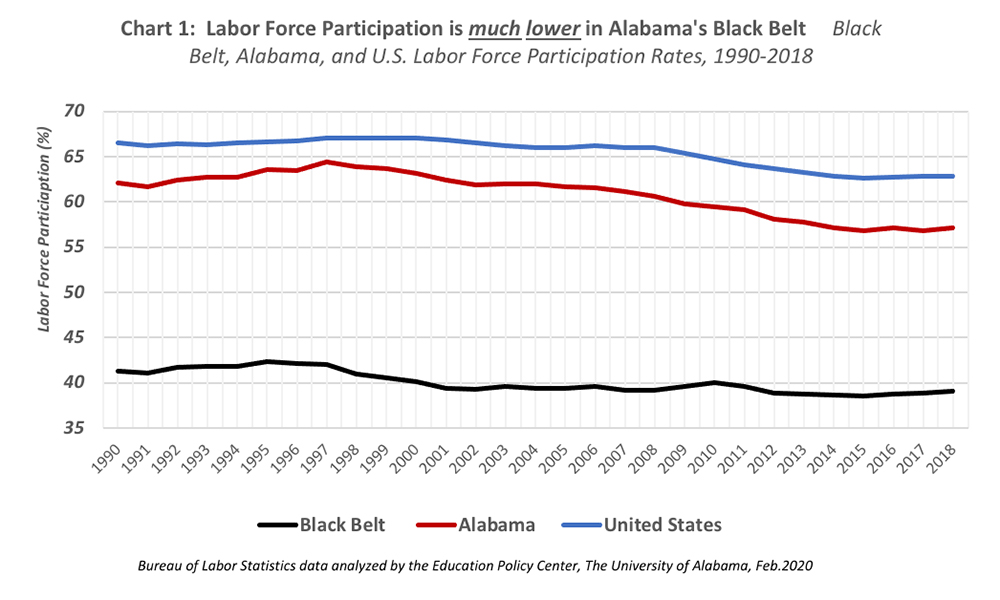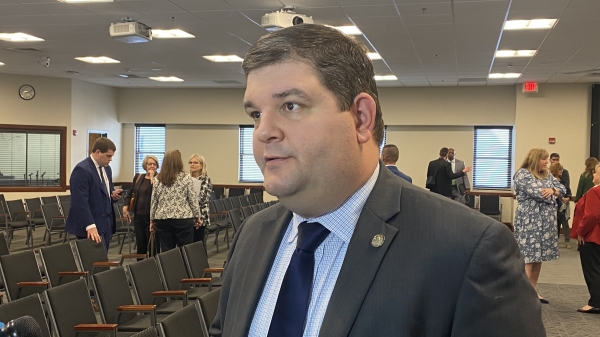The labor force participation rate in Alabama’s Black Belt region has been 20 percentage points lower than the rest of the state and the nation for nearly three decades, a report released Monday by The University of Alabama’s Education Policy Center.
That fact didn’t surprise several employment experts in a briefing on the report with reporters Monday, who described work being done to expand existing work training programs and to get the needed participation from local leaders in those communities.
Between April 20 and July 20 of this year, there was an uptick in he numbers of people living in the Black Belt who were participating in the labor force, rising from approximately 273,000 people to just more than 284,000.
The report’s researchers hypothesis that the recent increase may be due to people returning to work to help support their families during the COVID-19 pandemic, but looking at the area over time, it’s clear that the Black Belt lags behind the rest of the state and country. Those who are considered to be active in the labor force are those who are either working or seeking employment.
Between 2010 and 2019 Alabama saw a marginal increase in labor force of about 2 percent, while the country as a whole experienced an increase of approximately 6 percent. Alabama’s Black Belt region, however, saw a decrease of more than 5 percent during that time, according to the report.
In 2010 the Black Belt region had almost 300,000 people in the labor force, which dropped to around 282,000 people, according to the report.
The report, titled “The Black Belt’s Labor Force Participation Lags Behind the Rest of Alabama & the Nation,” is the latest in the center’s eight-part series, “Black Belt 2020.”
“The data is more alarming in some ways, but at the same time it’s not necessarily surprising,” said Dan Hull, director of Career and Technical Education at the Alabama State Department of Education, speaking to reporters during the briefing Monday.
Population growth and school enrollment have continued to drop in the Black Belt region in recent decades, Hull said, but he stressed the importance of broadening awareness among school children of the opportunities that exist for them.
“One of the sayings that we have in K-12 is kids, it’s just really hard for them to be what they can’t see, so we want to provide more opportunities for students to really just understand what’s available and what’s out there,” Hull said.
Hull said officials wants to expand and further develop the workplace learning concept, where students spend half a school day working at a job, and they want to reach down into middle and elementary schools to help those younger children become aware earlier of what opportunities await them.
Jinping Sun, assistant professor in the Department of Educational Leadership, Policy and Technology Studies at the University of Alabama, said during the briefing that what stood out to her after reviewing the report was the need to develop high quality leadership in Black Belt schools.
Data shows that school achievement has a clear and direct impact on future employment, Sun said, and it also shows that increasing quality leadership among school principals has a clear impact on student testing scores.
“If we could focus on the development of school leaders, and district leaders, and then in one or two years, our scores would rise by 20 percent to 15 percent,” Sun said. “We would surpass a lot of states.”
Donny Jones, vice president of the West Alabama Chamber of Commerce and executive director of West Alabama Works, said now is the time to make systemic changes in the Black Belt.
“If we ever had a perfect moment to really come together and make transitional changes in our education system, in our workforce system and the modeling that we actually do, I think now’s the time,” Jones said.
Jones said they’re now in the second year of the Educator Workforce Academy, which is a yearlong program for West Alabama teachers that trains them on workforce development.
“What we’re finding out is many of our educators have said to us, we had no idea that these opportunities are in our own community for young people, and didn’t really understand what they could do to support the workforce and also the opportunities for their children,” Jones said.
Young people are graduating school and leaving the Black Belt for jobs elsewhere, Jones said, which makes programs like the Educator Workforce Academy so important. There are companies in the Black Belt who need workers but are finding them from outside those areas, while young people are leaving for jobs elsewhere, he said, adding that there needs to be a comprehensive plan.
“We need to take these comprehensive plans that we have been talking about for years, and actually putting them into actionable programs that actually can make a systemic change,” Jones said. “And it’s got to go all the way down to Pre-K, from Pre-K all the way up to PhD. we’ve got to create those education programs, but also pipelining all of the workforce programs that we have into actual jobs.”
Asked by APR whether anyone is actively working on such a comprehensive plan for the Black Belt, or whom that person or group might be, if not, it was unclear Monday.
Stephen Katsinas, director of the University of Alabama’s Education Policy Center, said it’s critical that we first define exactly what is the Black Belt so that it can be measured. Over the years, various counties have been added, then taken away, from the generally used makeup of Black Belt counties.
“The fact that we don’t even have a definition of the Black Belt says a lot about the commitment that we’ve made to it,” Katsinas said.
Last week the Education Policy Center released its report titled “Persistent Unemployment in the Black Belt.” Visit the center’s website here to learn more about past reports.




















































